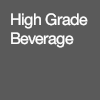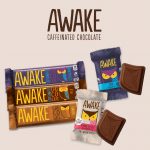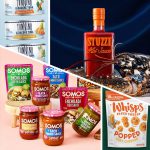The Ultimate 2015 Food and Beverage Trend List
We’re on the cusp of a new year, and while most of the world has wound down for the holidays, trend watchers, on the other hand, have been quite busy. In recent weeks, we’ve been inundated with reports from market research firms, trade groups and PR agencies on what to expect for food and beverage trends in 2015.
As your conduit for all things trending, FBU compiled a master list. Included is an array of information on expected trends for packaged food and beverage manufacturers, restaurants, flavor companies, drink, and label providers. We also included insights from industry experts who attended our most recent BevNET Live conference in Santa Monica.

This list will help offer entrepreneurs some insights as to what’s hot and what’s soon to be on-trend for the coming year. And if after reading this report, you decide on making an ugly root vegetable chip fortified with insect flour, or brew an un-hopped beer flavored with herbs, spices and bitters, we at FBU would love to try it – or at least hear from you about it.
Restaurant Food Trends
While we’re not directly focused on the business of restaurants at FBU, we’re aware that restaurant trends often make their way into packaged goods, and vice-versa. A majority of restaurant social trends to watch for in 2015 relate to health and environmental sustainability, including the use of more “ugly” vegetables, which had often been discarded for aesthetic reasons. They are, however, becoming more readily accepted as consumers focus on the environment and reducing food waste. “Ugly” vegetables also draw appeal because they are more likely to be identified with unmodified, “heirloom” strains of products rather than those bred for eye-appeal.

Also interesting for the coming year is the increased use of neurogastronomy — the science of how the brain creates the sensation of flavor and taste — in the restaurant setting. Chef Ferran Adrià, the poster boy for molecular gastronomy, demonstrated through his studies that a pink strawberry dessert tastes 10 percent sweeter on a white plate than a black. Curved chocolate apparently releases different flavors than angular chocolate. Other studies, like the one done by the Arizona Science Center says red and yellow colors make you hungrier. (Did somebody say McDonald’s?)
As for ingredients and plated foods, oysters and savory yogurts made it onto several lists. Meanwhile, Asian flavors reigned across the board as consumers increasingly embrace tastes and exotic ingredients found in Vietnamese and Filipino cuisine. Underutilized or previously undesired animals or parts of animals seem to be big in restaurants as well, with ears, cheeks and intestines in high demand from restaurant goers. Finally, fermented foods showed up in several reports from food consultants like Baum and Whiteman, the National Restaurant Association and in publications like U.S. News.
Expected Restaurant Trends for 2015
1. Environmental sustainability
2. Locally sourced meats/seafoods
3. Natural ingredients
4. Food waste reduction
5. Farm-branded items
6. Healthful kids items
7. Smaller plates
8. New cuts of meat
9. Neurogastronomy
10. Doughnuts
11. Underutilized fish
12. Grass-fed burgers
13. Ugly fruits and root vegetables
14. Seaweed
15. Flavored Honey
16. Savory,sweet yogurt and ice cream
17. Underutilized pig parts: guanciale, pancetta, fried ears, ndjua
18. Oysters
19. Asian Flavors
20. Fermented Foods
21. Clashing flavors e.g. salty and bitter
Packaged Foods Trends
Overarching food trends continue to focus on health and convenience. Consumers are increasingly consuming plant-based proteins, fermented products believed to benefit the digestive system, and — especially Baby Boomers — snacks that provide healthy benefits like protein and fatty acids.

Meanwhile, experts say that brands need to start reaching out to members of Generation Z, the generation that follows millennials. They say Generation Z was exposed to more types of foods at earlier ages. They want diversity in their meals, so instead of everyday breakfast foods like eggs, experts say Generation Z is interested in frittatas or quiches with fresh herbs instead.
Foods made with specialty ingredients may not be showing up in every store in the country, but the segment is one in which entrepreneurs are making some of the biggest strides in innovation. Consider that insect-based protein bars have already hit the market (yes, you read that right). Bug protein is also finding their way into other products like chips, tacos, pastas and flour. And while it remains to be seen if insect protein will be deemed as a “superfood” for 2015, look out for exotic grains like kaniwa — said to be the new quinoa — to be part of next year’s breakout stars. Kaniwa contains high levels of protein and amino acids, fruits like baobab, which have unusually high levels of vitamin C, and soursop, a Central and South American tree fruit packed with vitamin B and C.
Bone broth, which was hailed as “winter’s new miracle drink” by The Washington Post, is definitely something to keep an eye on. The nutrients released from boiling bones — be it from chickens, pigs, or cows — are said to be beneficial for bone formation and reducing joint pain and inflammation. Bone broth has also been lauded as a digestive agent and a food that helps reduce the length of colds, so don’t be surprised if you a bottle of the stuff hit the shelf in 2015.
Expected Packaged Food Trends for 2015
- Pickling/fermentation
- Insect-based ingredients and foods
- Seaweed
- Plant and algae-based protein
- Natural ingredients and minimally processed foods
- Esoteric Japanese snack foods
- Coconut sugar
- Culinary cannabis
- Super fruits
- Bone broth
- On-the-go healthy bowls
- Baby Boomer snack trends
- Generation Z entering the scene
- Better-for-you ingredients/functional foods
- Mass produced to personalized
- Convenient frozen foods
- Same-day fresh grocery delivery
- Private label foods and beverages
Flavor Trends in Foods
In terms of flavors, smoked and spicy dominated the boards. Asian flavors like kimchi and umami from seaweed are also huge. Many lined up with those seen in restaurants, in that applying a savory application to something that was once sweet, such as yogurt or ice cream, seems quite popular. For example, in Japan, Haagen-Dazs sells a tomato-cherry ice cream, while some gelato shops in Rome now sell artisanal gelato with gorgonzola, artichokes and anchovies. Despite the seemingly stomach-churning combinations, we continue to see new and unique flavors wiggle their way into mainstream mouths. And as awkward as they might seem, Japanese snack foods like shrimp-and-mayonnaise Doritos and apple-flavored Kit-Kats should be kept on the watch list for American consumers in 2015.

Expected Flavor Trends in Foods for 2015
1. Flavored honey
2. Smoked flavors
3. Hot and spicy
4. Bitter
5. Savory substituting sweet
6. Advanced Asian flavors
7. Latin American flavors
Beverage Trends
Consumers like craft and custom-made beverages like sodas, which made it onto several trend lists including that of market research provider Technomic and Baum and Whiteman. Moving onto consumers’ continuing interest in healthier products, there’s a focus on decreased sugar consumption and increased nutrient benefits. Specialty teas with flavors upgrades and health benefits are also trending as are cold-pressed juices, which are said to be higher in nutritional content than traditionally processed juice products.

In the alcoholic realm, imparting herbal flavors in cocktails, whiskeys and beer is big. Baum and Whiteman’s have cited consumers increasingly embracing the added body and depth that herbal flavors add. On the same note, fuller-bodied and more heavily flavored liquors such as whiskey are being desired by Americans. In October, whiskey investment specialist, The Whisky Corporation, reported that brown whiskey overtook vodka in sales for the first time since 2007.
Expected Beverage Trends for 2015
Non-Alcoholic
- Hand-crafted flavored sodas
- Plant-based “waters”
- Packet flavor enhancers
- Horchata
- Specialty teas
- Matcha
- Juice bars
- Cold-pressed juice
Alcoholic
- Whiskeys and spiced rums
- Herb-infused liquors and beer
- Locally produced beer/wine/spirits
- Micro-distilled artisan spirits
- On-site barrel-aged drinks
- Culinary/regional signature cocktails
Labeling Trends
Part of staying on trend in the food and beverage industry isn’t just what you put in the product; it’s what you put on the label. Non-GMO, kosher, gluten-free, dairy-free, vegan, paleo-friendly; you name it, someone’s built out a badge for it. Certain labeling trends seem to have captured consumers’ attention, and paying attention to them may help newer products.
Predictions from varying sites 2015 show “clean and clear labeling” as the winner. Innova Market Insights, an online food and beverage database, said that nearly a quarter of all food and beverage launches emphasized the natural aspects and origins of the product. The lack of a clear definition for the term “natural” has caused leading-edge manufacturers to provide even clearer, more transparent details about product attributes.
It’s not just “clean and clear” labeling making the list. Here are some comparisons of labeling statistics on new product launches between 2009 and 2014 from Mintel using data from Global New Products Database.
- Kosher: Up from 26.6 percent in 2009 to 40.6 percent in 2014. Health-conscious consumers are linking Kosher to “more wholesome.”
- Allergen claims (dairy-free, soy-free, etc.): Up from 8.5 percent in 2009 to 25 percent in 2014.
- Environmentally friendly packaging: Up from 8.5 percent in 2009 to 21.8 percent in 2014.
- No additives/preservatives: Up from 13.2 percent in 2009 to 18.6 percent in 2014.
- Gluten-free: Up from 12.1 percent in 2009 to 23.6 percent in 2014.
- Non-GMO/GMO-free: Surged from 1.9 percent in 2009 to 10.2 percent in 2014.
“Natural” claim labeling has hovered at about 13 percent for the past six years, but could drop in 2015 due to the term’s ambiguity and ongoing lawsuits about natural-based claims.
Vegan ingredients are also on the rise, increasing from 1.52 percent of new launches in 2009 to 5.31 percent in 2014.
It appears that low/no/reduced sugar claims are holding steady even though the FDA has proposed requiring manufacturers to list “added sugar” on nutrition facts panels. Instead companies continue to point out the use of natural sweeteners or real sugar in their products.
Finally, social media-related labeling has risen in visibility from 4 percent in 2012 to 13.24 percent in 2014. This rise represents the seeming popularity of the need for connection between the product and consumer, an aspect of of marketing popular with millennial consumers.













